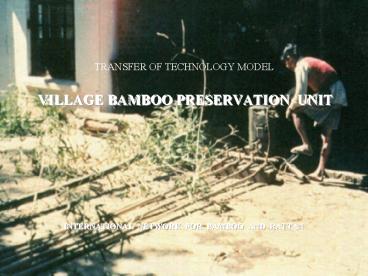TRANSFER OF TECHNOLOGY MODEL VILLAGE BAMBOO PRESERVATION UNIT - PowerPoint PPT Presentation
1 / 9
Title:
TRANSFER OF TECHNOLOGY MODEL VILLAGE BAMBOO PRESERVATION UNIT
Description:
Bamboo is kept in hot Preservative is forced into Bethel process, but pressure ... for a short time, but modern preservatives are more effective in the long term. ... – PowerPoint PPT presentation
Number of Views:645
Avg rating:3.0/5.0
Title: TRANSFER OF TECHNOLOGY MODEL VILLAGE BAMBOO PRESERVATION UNIT
1
TRANSFER OF TECHNOLOGY MODEL VILLAGE BAMBOO
PRESERVATION UNIT
- INTERNATIONAL NETWORK FOR BAMBOO AND RATTAN
2
Why bamboo?
- Bamboos grow more rapidly than trees and start to
yield within three or four years of planting. - Plantation establishment requires minimal capital
investment and builds upon the inherent
plant-cultivation skills of local farmers and
foresters. - Bamboos can be harvested annually and
non-destructively. - Bamboos are excellent for rejuvenating degraded
lands and protecting against soil erosion. - Bamboos may easily be intercropped with
shallow-rooted crops. - As well as the culms, all other parts of the
bamboo plant can be used in rural livelihoods -
shoots for food, leaves for fodder, and branches
for items such as brooms and for firewood.
3
Why preserve bamboos?
- Bamboos are a natural material and will decay
with time. They are also susceptible to insect
and fungal attack. - Preserving bamboos increases the durability of
the culms and increases the lives of the products
they are used to produce. It also increases the
safety of any structures in which they are used
as load bearing members. If used as structural
components they need to be replaced less often
which reduces costs in the long term. - Preserved bamboos fetch higher prices than
non-preserved bamboos.
4
What are the main methods of bamboo preservation?
- 1. Sap displacement The 2. Diffusion
process Culms 3. Boucherie process - sap of the bamboo is are fully
immersed in Preservative is pumped - replaced by preservative. preservative.
through the bamboo. -
- 4. Hot and cold process 5. Full cell (Bethel)
process 6. Empty cell process As the - Bamboo is kept in hot Preservative is
forced into Bethel process, but pressure - preservative for 2-3 the bamboo
under high is released in the vessel
to - hours. pressure. expel
excess preservative.
5
Main development attributes of a village bamboo
preservation unit
- Reduces dependence on timber resources and
thereby increases environmental protection and
conservation. - Permits rehabilitation of degraded lands through
increased areas of bamboo plantations. - Creates income-generating opportunities for
bamboo growers who will supply the unit, and
employment for unskilled and semi-skilled workers
at the unit. - Requires minimal capital investment to establish.
- Promotes greater acceptability of bamboo, with
consequent benefits for all aspects of the
community involved with bamboo.
6
Some salient facts
- Preservation of bamboo is an intermediate stage
between cultivation and final processing and
requires good linkages to the final processors. - Treated bamboo can be sold for double the price
of untreated bamboo.
- Bamboo culms have a life of only 3 years once
severed from the plant, and often much less. - The earliest preservation treatment for bamboo
was soaking in water. This is still effective on
a very small scale and for a short time, but
modern preservatives are more effective in the
long term. - As a primary processing activity the preservation
unit is ideally established as one of the central
core units in a broader, community-based, bamboo
development programme, along with a bamboo
splitting and slivering unit and a bamboo
propagation unit.
Photo A hut made of preserved bamboo
7
Requirements for success
- Sustained supply of bamboos.
- Some technically-trained personnel to manage and
maintain the unit. - A small amount of start up capital.
- Willingness of the village community to establish
a cooperative. - Proper linkages to the users of the treated culms.
Left Schematic diagram of the modified Boucherie
preservation process.
8
Financial aspects of a village bamboo
preservation unit
- START UP COSTS (US Dollars)
- Steel drum for steeping
- and sap displacement. 5
- Steel tank for diffusion or 500
- masonry tank for diffusion. 200
Boucherie equipment. (for 50 bamboos at a
time) 500 Hot and Cold bath
2000 Pressure cylinder 5000
- RUNNING COSTS
- Bamboo purchase 10-15 cents/m
- Treatment cost 5-8 cents/m
9
For further information
- See
- TOTEMs
- Bamboo preservation by sap displacement.
- Rattan oil curing, bleaching and preservation
- Websites
- INBAR www.inbar.int
- FRI Dehradun www. envfor.nic.in/icfre/fri/fri.htm
l - Books
- Bamboo Preservation Techniques -
- A Review. 1994.
- By Sathish Kumar, K.S. Shukla, Indra Dev,
- P.B. Dobriyal. Published by INBAR and ICFRE
- (available as text file at
- http//www.inbar.int/publication/publmain.asp?cate
codepp)
- Contact
- INBAR, Beijing 100101-80, China
- Forest Research Institute, 40 Trevor road, New
Forest, Dehradun, 248 006, India































